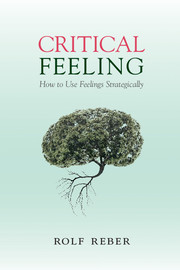Book contents
- Frontmatter
- Dedication
- Contents
- Preface
- Part I The basics of critical feeling
- Part II Applications of critical feeling
- 4 Happiness through critical feeling
- 5 The role of sensory and bodily feedback
- 6 Living together
- 7 Critical feeling in business and politics
- 8 Critical feelings at school
- 9 Music, art, and literature
- 10 Religion and morality
- Epilogue
- Notes
- References
- Index
8 - Critical feelings at school
from Part II - Applications of critical feeling
Published online by Cambridge University Press: 05 March 2016
- Frontmatter
- Dedication
- Contents
- Preface
- Part I The basics of critical feeling
- Part II Applications of critical feeling
- 4 Happiness through critical feeling
- 5 The role of sensory and bodily feedback
- 6 Living together
- 7 Critical feeling in business and politics
- 8 Critical feelings at school
- 9 Music, art, and literature
- 10 Religion and morality
- Epilogue
- Notes
- References
- Index
Summary
From the standpoint of the child, the great waste in the school comes from his inability to utilize the experiences he gets outside the school in any complete and free way within the school itself; while on the other hand, he is unable to apply in daily life what he is learning in school. That is the isolation of the school – its isolation from life. When the child gets into the schoolroom he has to put out of his mind a large part of the ideas, interests and activities that predominate in his home and neighborhood. … A gap [exists] between the everyday experiences of the child and the isolated material supplied in such large measure in the school.
(John Dewey 1956/1899, p. 75–76)John Dewey's (1956/1899) take-home message was that there exists a gap between school and home that makes school a bleak place without life. The take-home message of this chapter is that critical feeling can improve this state by employing strategies aimed at enhancing the experience of learning, by making learning interesting, and by fostering intuition and insight. The chapter has four sections. First, I review evidence that metacognitive feelings enhance the learning process, in line with the claim in Chapter 5 that each act of perception and thought – and therefore of learning – is accompanied by a feeling. Second, I discuss emotions in the classroom. The third section will address the closing of the gap between school and the life of the child. Knowledge about how to catch the attention of students enables teachers to make instruction lively and content interesting. The final section of this chapter reveals how school can be filled with life by fostering intuition and by eliciting aha-experiences.
Thus far I have addressed questions concerning education at the end of each chapter in Part II. I have looked at how parents and instructors may teach critical feeling in various domains, such as well-being, skill learning, living together, and marketing. This chapter looks at critical feeling within school education. Proponents of a liberal society may be skeptical about the role of schools in critical feeling; they may argue that parents educate their children while schools are institutions that impart the knowledge necessary for the future economic success of both the students and the nation; they may encounter the notion of an education to happiness with skepticism, …
- Type
- Chapter
- Information
- Critical FeelingHow to Use Feelings Strategically, pp. 180 - 198Publisher: Cambridge University PressPrint publication year: 2016



